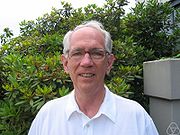Charles Sims (mathematician)
- Charles Sims (mathematician)
-

Charles C. Sims, 2006 (photo by Renate Schmid)
Charles Coffin Sims (born 1938) is an American mathematician best known for his work in group theory. Together with Donald G. Higman he discovered the Higman–Sims group, one of the sporadic groups. The permutation group software developed by Sims also led to the proof of existence of the Lyons group (also known as Lyons–Sims group) and O'Nan group (also known as O'Nan–Sims group).
Sims was a student of John Thompson and received Ph.D. from Harvard University in 1963. In his thesis he enumerated p-groups, giving sharp asymptotic upper and lower bounds. Sims is one of the founders of computational group theory and is the eponym of the Schreier–Sims algorithm. He was a faculty member at the Department of Mathematics at Rutgers University from 1965 to 2007. During that period he had served, in particular, as Department Chair (1982–84) and Associate Provost for Computer Planning (1984–87). Sims retired from Rutgers in 2007 and currently resides in St. Petersburg, Florida.[1]
See also
References
External links
| Persondata |
| Name |
Sims, Charles C. |
| Alternative names |
|
| Short description |
|
| Date of birth |
1938 |
| Place of birth |
|
| Date of death |
|
| Place of death |
|
Categories:
- 1938 births
- American mathematicians
- 20th-century mathematicians
- Group theorists
- Computational group theory
- Harvard University alumni
- Rutgers University faculty
- Living people
- American mathematician stubs
Wikimedia Foundation.
2010.
Look at other dictionaries:
Charles Sims — may refer to: Charles Sims (painter) (1873–1928), British painter Charles Sims (mathematician) (born 1938), American mathematician Charles Sims (aviator), World War I flying ace Charles Edward Sims (1925–1983), State Librarian of Kansas,… … Wikipedia
Groupe de Higman-Sims — En mathématiques, le groupe de Higman–Sims est un groupe sporadique simple fini d ordre 29 · 32 · 53 · 7 · 11 = 44 352 000. Il peut être caractérisé comme le sous groupe simple d index 2 dans le groupe des… … Wikipédia en Français
Edward Wright (mathematician) — For the 20th century mathematician, see Edward Maitland Wright. Edward Wright Title page of the first edition of Wright s Certaine Errors in Navigation (1599) … Wikipedia
Higman–Sims group — In the mathematical field of group theory, the Higman–Sims group HS (named after Donald G. Higman and Charles C. Sims) is a finite group of order : 29 · 32 · 53 · 7 · 11: = 44352000.: ≈ 4 · 107.It is a simple group , meaning it does not have any… … Wikipedia
Graham Higman — G. Higman en 1960 Graham Higman (né le 19 janvier 1917, mort le 8 avril 2008) est un mathématicien britannique connu pour ses contributions à la théorie des groupes. Il a fondé le Journal of Algebra … Wikipédia en Français
Вычислительная теория групп — область науки на стыке математики и информатики[1], изучающая группы с помощью вычислительных машин. Она связана с проектированием, анализом алгоритмов и структур данных для вычисления различных характеристик (чаще всего конечных) групп. Область… … Википедия
List of alumni of The Citadel, The Military College of South Carolina — This is a short list of notable alumni from The Citadel, The Military College of South Carolina. Contents 1 Military 2 Business 3 Sports 4 Government … Wikipedia
List of 1632 characters — Main article: List of 1632 characters (fictional) Main articles: 1632 series and The Grantville Gazettes This is a list of the many historical characters that appear in over twenty works of Eric Flint s 1632 series. In the fictional world, the… … Wikipedia
MacArthur Fellows Program — For the award in the field of ecology, see Robert H. MacArthur Award. The MacArthur Fellows Program or MacArthur Fellowship (nicknamed the Genius Award) is an award given by the John D. and Catherine T. MacArthur Foundation each year to typically … Wikipedia
Transcendental Meditation technique — This article is about the technique. For the movement, see Transcendental Meditation movement. The Transcendental Meditation technique is a specific form of mantra meditation[1] often referred to as Transcendental Meditation. It was introduced in … Wikipedia

